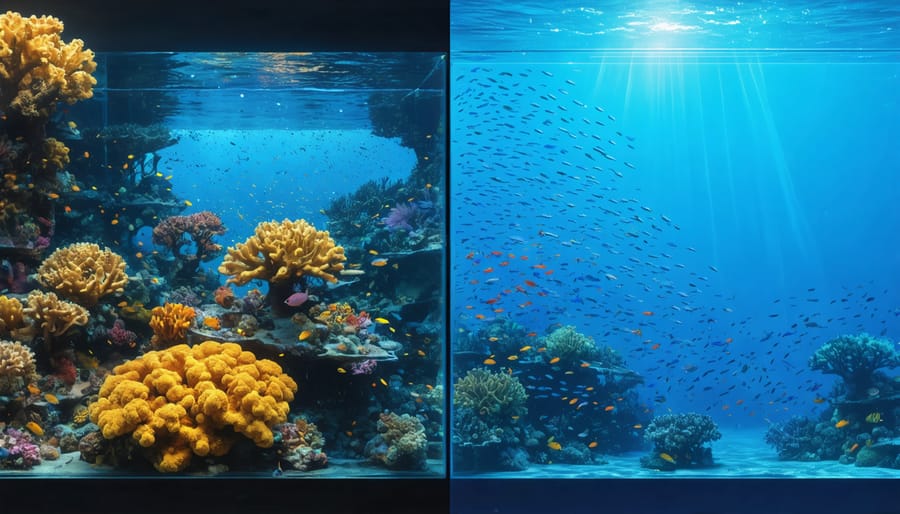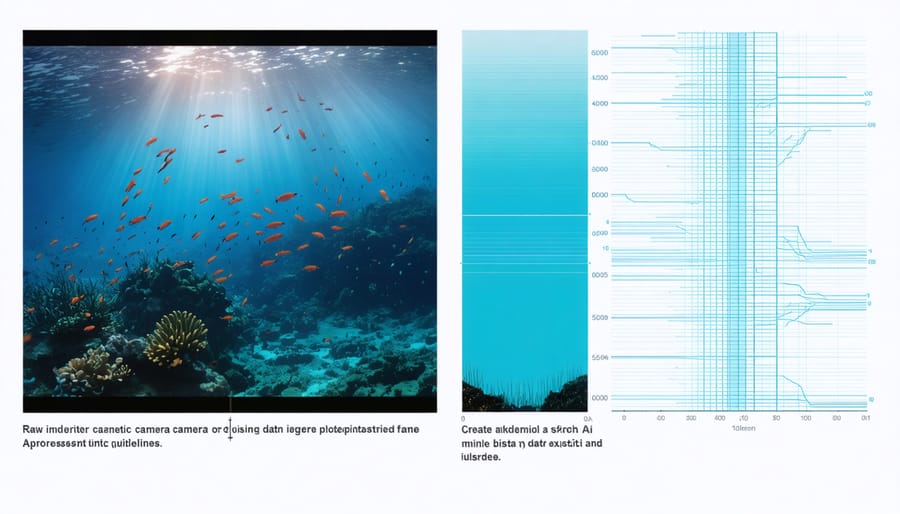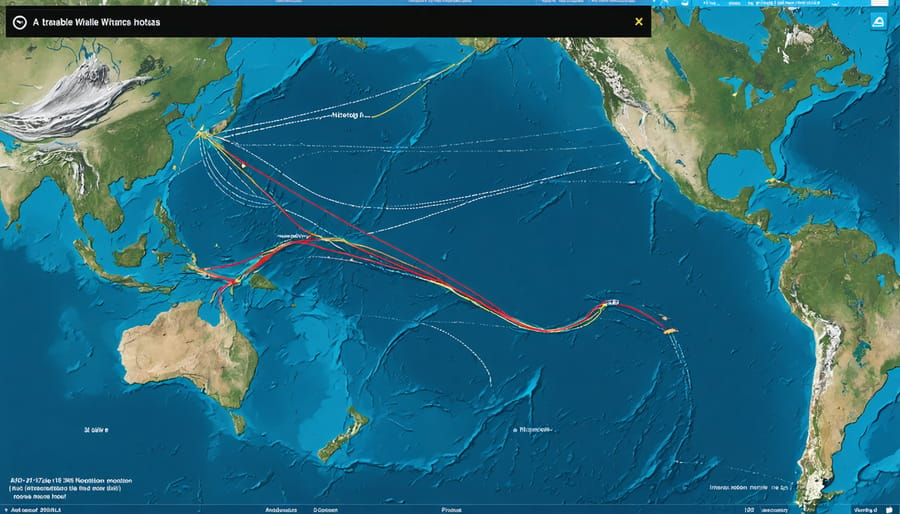
In the depths of our oceans, a revolutionary partnership between artificial intelligence and marine science is reshaping our understanding of complex ecosystem interactions. Advanced AI algorithms now decode decades of marine species data in hours, revealing hidden patterns that once took researchers years to uncover. From tracking whale migrations through satellite imagery to predicting coral reef resilience using deep learning models, AI-driven analysis has become an indispensable tool in marine conservation efforts.
The convergence of machine learning with traditional marine biology offers unprecedented insights into species behavior, population dynamics, and ecosystem health. By processing vast amounts of environmental data – from temperature fluctuations to chemical compositions – AI systems help scientists predict and respond to threats facing marine life with remarkable precision. This technological evolution represents more than just improved efficiency; it marks a fundamental shift in how we study, protect, and restore our ocean’s biodiversity.
As we stand at this crucial intersection of technology and conservation, the promise of AI-driven marine research extends beyond pure science. These innovations empower conservationists with real-time decision-making capabilities, enable more effective marine protected area management, and provide powerful tools for engaging public support in ocean conservation efforts. The future of marine conservation lies in our ability to harness these intelligent systems while maintaining the human element that drives our commitment to ocean stewardship.
The Power of AI in Marine Research
Machine Learning Applications
Modern machine learning applications have revolutionized how we study marine species interactions. Deep learning algorithms now analyze vast quantities of underwater footage, identifying and tracking multiple species simultaneously with remarkable accuracy. For instance, researchers at the Woods Hole Oceanographic Institution use AI to monitor coral reef ecosystems, detecting subtle changes in fish behavior and population dynamics that might otherwise go unnoticed.
Computer vision systems equipped with neural networks can identify individual whales by their unique markings, helping scientists track migration patterns and social behaviors. In the Mediterranean, AI-powered acoustic monitoring systems analyze dolphin vocalizations, providing insights into pod communications and social structures.
Particularly promising is the use of predictive modeling to forecast potential species interactions in changing ocean conditions. These models help marine biologists anticipate how climate change might affect predator-prey relationships and ecosystem balance, enabling more proactive conservation strategies. Scientists can now process years of data in days, dramatically accelerating our understanding of marine ecosystems and their preservation needs.

Data Collection Revolution
The advent of AI technology has revolutionized how we collect and process marine ecosystem data. Traditional methods of gathering information about marine species interactions often involved countless hours of manual observation and limited sampling. Today, autonomous underwater vehicles equipped with AI-powered sensors can continuously monitor vast ocean areas, collecting data 24/7 in conditions that would be challenging or impossible for human researchers.
These smart systems can simultaneously track multiple parameters, from water temperature and chemistry to species movements and behavioral patterns. Marine biologists now have access to millions of data points that would have taken decades to collect manually. For instance, AI-enabled cameras can identify and count different fish species in real-time, while machine learning algorithms process complex sonar readings to map coral reef structures and monitor their health.
Citizen scientists also play a crucial role in this data revolution. Through mobile apps and online platforms, volunteers worldwide contribute valuable observations that AI systems analyze to identify patterns and trends in marine ecosystems. This combination of artificial and human intelligence has created unprecedented opportunities for understanding and protecting our oceans.
Real-World Applications
Predator-Prey Relationships
Artificial Intelligence has revolutionized our understanding of predator-prey relationships in marine ecosystems by processing vast amounts of data to identify patterns and predict hunting behaviors. Advanced AI models analyze multiple variables simultaneously, including migration routes, feeding times, and population densities, to create comprehensive models of food chain dynamics.
Marine biologists are now using AI-powered systems to track the movement patterns of apex predators like great white sharks and orcas, correlating their hunting behaviors with the distribution of prey species. These systems can predict potential feeding grounds and help researchers understand how environmental changes affect predator-prey interactions.
For example, in the Mediterranean Sea, AI models have successfully mapped the relationship between bluefin tuna and their prey species by analyzing decades of fishing data, satellite imagery, and ocean temperature readings. This has led to more effective conservation strategies and sustainable fishing practices.
Machine learning algorithms are particularly effective at identifying subtle changes in ecosystem balance. They can detect early warning signs of population collapse by monitoring variations in predator-prey ratios and alerting conservationists to potential issues before they become critical.
The technology also helps in understanding how climate change impacts these relationships. AI models can simulate future scenarios, showing how warming oceans might affect predator hunting success rates and prey survival strategies, enabling proactive conservation measures.
Migration Pattern Analysis
Artificial intelligence has revolutionized our ability to track and understand marine species’ movement patterns, creating unprecedented insights into migration behaviors and critical interaction zones. Advanced machine learning algorithms now process vast amounts of data from satellite tracking, acoustic monitoring, and environmental sensors to create detailed migration maps and predict future movement patterns.
These AI systems can identify patterns that might be invisible to human researchers, such as subtle changes in migration timing due to ocean temperature fluctuations or shifts in prey distribution. For instance, researchers studying whale populations off the California coast have used AI to analyze decades of tracking data, revealing how shipping routes intersect with migration corridors and helping to reduce vessel strikes.
The technology excels at processing multiple data streams simultaneously, combining information about ocean currents, water temperature, prey availability, and historical movement patterns to predict where different species are likely to interact. This capability has proven invaluable for identifying potential conflict zones between marine mammals and fishing operations, as well as pinpointing critical areas for conservation efforts.
Citizen scientists and marine observers can now contribute to these efforts through mobile apps that use AI to verify species identification and track movement patterns in real-time. This collaborative approach has created a robust network of data collection points, enhancing our understanding of marine species interaction and supporting more effective conservation strategies.

Conservation Impact
Habitat Protection
Artificial intelligence is revolutionizing how we identify and protect critical marine habitats. By analyzing vast amounts of data from satellite imagery, underwater sensors, and marine species tracking devices, AI systems can now pinpoint areas of high ecological importance with unprecedented accuracy. These smart systems detect patterns in marine life movements, water quality changes, and ecosystem interactions that might be impossible for human researchers to identify alone.
Marine conservationists are using AI-powered mapping tools to create detailed habitat models that show where different species feed, breed, and migrate. This technology has been particularly effective in identifying previously unknown coral reef systems and seagrass meadows, which serve as crucial nurseries for countless marine species.
In practical applications, AI helps conservation teams respond more quickly to environmental threats. For instance, when AI systems detect unusual changes in water temperature or chemical composition, they can alert researchers to potential threats to sensitive habitats. This early warning system has proven invaluable in preventing coral bleaching events and protecting endangered species’ breeding grounds.
The technology also assists in monitoring protected marine areas, using computer vision to identify illegal fishing activities and track vessel movements that might threaten delicate ecosystems. This automated surveillance has significantly improved enforcement efforts and habitat preservation success rates.

Species Protection
Artificial intelligence is revolutionizing endangered species conservation efforts through advanced population monitoring and management systems. These AI-driven solutions analyze vast datasets from camera traps, satellite imagery, and acoustic sensors to track endangered species movements, behaviors, and population dynamics in real-time.
Machine learning algorithms can now identify individual animals within populations, monitor breeding patterns, and predict migration routes with unprecedented accuracy. For example, researchers use AI to analyze underwater photographs and recordings to track whale populations, helping conservation teams better understand their behaviors and protect critical habitats.
AI systems also help predict and prevent human-wildlife conflicts by analyzing historical data and environmental factors. These predictive models enable conservationists to implement proactive measures, such as establishing protected corridors or adjusting shipping routes to avoid whale collisions.
The technology has proven particularly valuable in combating wildlife trafficking. AI-powered surveillance systems can detect poaching activities and alert authorities immediately, while machine learning algorithms scan social media and online marketplaces to identify illegal wildlife trade networks.
These innovations are transforming how we protect vulnerable species, offering hope for the preservation of Earth’s biodiversity for future generations.
Future Perspectives
The future of AI-driven marine research holds tremendous promise, with emerging technologies poised to revolutionize our understanding of ocean ecosystems. Machine learning algorithms are becoming increasingly sophisticated, enabling real-time analysis of marine species interactions and behavioral patterns. Scientists anticipate that advanced neural networks will soon be capable of predicting migration routes with unprecedented accuracy, helping protect endangered species more effectively.
One particularly exciting development is the integration of quantum computing with AI systems, which could dramatically enhance our ability to process complex ecological data. This combination may unlock new insights into marine food webs and ecosystem dynamics that were previously impossible to detect with traditional methods.
Autonomous underwater vehicles equipped with AI are expected to become more prevalent, capable of conducting long-term monitoring missions without human intervention. These systems will likely incorporate advanced sensor technologies and improved pattern recognition capabilities, allowing for more detailed studies of deep-sea environments and previously inaccessible marine habitats.
Citizen science initiatives are also evolving, with AI-powered mobile apps enabling broader public participation in marine research. These tools will help bridge the gap between scientific research and public engagement, creating more comprehensive datasets while fostering environmental awareness.
Looking ahead, researchers anticipate that AI systems will play a crucial role in developing more effective conservation strategies, particularly in response to climate change impacts on marine ecosystems. This technology-driven approach to marine conservation offers hope for preserving our ocean’s biodiversity for future generations.
The integration of AI in marine species interaction research represents a transformative leap forward in our understanding and protection of ocean ecosystems. Through machine learning algorithms and advanced data analysis, we’re uncovering previously hidden patterns in marine life behavior and relationships that are crucial for effective conservation efforts. These technological innovations not only accelerate our research capabilities but also provide more accurate predictions about how climate change and human activities affect marine species interactions.
As we face increasing environmental challenges, supporting AI-driven marine research initiatives becomes more critical than ever. There are numerous ways to get involved, from citizen science projects that help train AI models through photo identification of marine species, to supporting organizations that develop and deploy AI technologies for ocean conservation. Educational institutions and research facilities are also seeking volunteers to assist with data collection and analysis.
The future of marine conservation depends on our ability to harness AI’s potential while maintaining the human element in research and protection efforts. By combining technological innovation with passionate advocacy and community engagement, we can work together to ensure the preservation of our ocean’s complex web of life for generations to come.
jessica
Ava Singh is an environmental writer and marine sustainability advocate with a deep commitment to protecting the world's oceans and coastal communities. With a background in environmental policy and a passion for storytelling, Ava brings complex topics to life through clear, engaging content that educates and empowers readers. At the Marine Biodiversity & Sustainability Learning Center, Ava focuses on sharing impactful stories about community engagement, policy innovations, and conservation strategies. Her writing bridges the gap between science and the public, encouraging people to take part in preserving marine biodiversity. When she’s not writing, Ava collaborates with local initiatives to promote eco-conscious living and sustainable development, ensuring her work makes a difference both on the page and in the real world.
